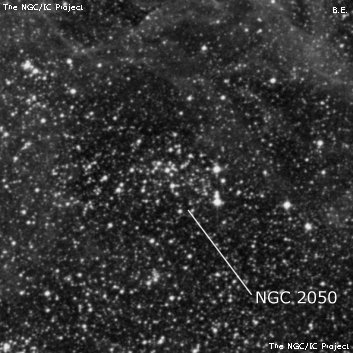
John Herschel discovered NGC 2050 = h2928 in 1834-1835 (exact date unknown as based on a sketch of the Tarantula Nebula (NGC 2070) made over several nights in Nov 1834 and Dec 1835). He described this object "Cl VI; vF st and nebulosity of irregular branching figure, or rather 3 clusters connected. See Notes on Catalogue of Nubecula Major." His position falls in the north-central portion of NGC 2055, a very large association and probably included part of the stream of stars mentioned in my description.. See Harold Corwin's notes for more on this object.
300/350mm - 14" (4/4/16 - Coonabarabran, 145x): NGC 2050 was taken as a 2'-3' patch of stars on the north side of the large stellar association LH 96, a 15'x10' cloud of roughly 120 stars. At 145x, ~20 stars were resolved including HD 37974, mag 10.9 blue supergiant at the west edge and a mag 10.7 star (11" double) at the southwest edge. The central part contains several mag 12 stars. A long stream of mag 10-12 stars begins about 12' SW of the cluster and extends east-northeast for over 20', passing just south of the Tarantula Nebula, and heads towards NGC 2100. Several of the nearby stars in this stream may also be part of NGC 2050.
400/500mm - 18" (7/8/02 - Magellan Observatory, Australia): at 173x, appears as just a locally brighter spot containing perhaps a dozen stars over a hazy background glow (stellar association LH 93), ~2' in diameter. Embedded in the edge of an amazing 15'-20' linear stream of stars (association LH 93/94) which runs through the field from east-northeast to west-southwest. This long chain passes just off the south side of the tendrils of the Tarantula Nebula and heads towards NGC 2050! NGC 2050 is situated 30' SW of the center of the Tarantula.
Notes by Steve Gottlieb